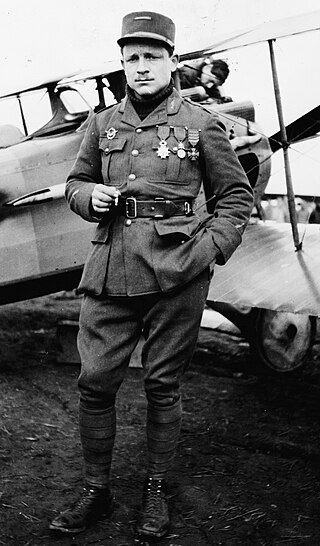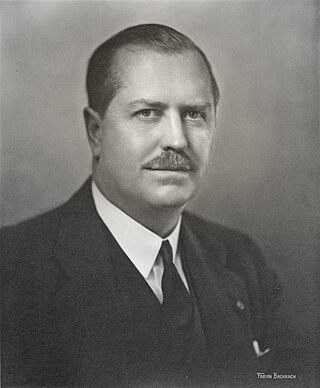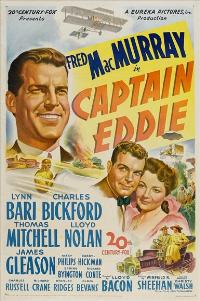
Edward Vernon Rickenbacker was an American fighter pilot in World War I and a Medal of Honor recipient. With 26 aerial victories, he was the most successful and most decorated United States flying ace of the war. He was also a racing driver, an automotive designer, and a long-time head of Eastern Air Lines.

Captain Field Eugene Kindley was an American aviator and World War I flying ace credited with twelve confirmed aerial victories.

Gervais Raoul Victor Lufbery was a French and American fighter pilot and flying ace in World War I. Because he served in both the French Air Force, and later the United States Army Air Service in World War I, he is sometimes listed alternately as a French ace or as an American ace. Officially, all but one of his 17 combat victories came while flying in French units.

Douglas Campbell was an American aviator and World War I flying ace. He was the first American aviator flying in an American-trained air unit to achieve the status of ace.

The Nieuport 28 C.1, a French biplane fighter aircraft flown during World War I, was built by Nieuport and designed by Gustave Delage. Owing its lineage to the successful line of sesquiplane fighters that included the Nieuport 17, the Nieuport 28 continued a similar design philosophy of a lightweight and highly maneuverable aircraft.

The 94th Fighter Squadron is a unit of the United States Air Force 1st Operations Group located at Joint Base Langley–Eustis, Virginia. The 94th is equipped with the F-22 Raptor.

The 1st Operations Group is the flying component of the 1st Fighter Wing, assigned to the USAF Air Combat Command. The group is stationed at Langley Air Force Base, Virginia. The 1st Operations Group is the oldest major air combat unit in the United States Air Force, being the successor organization of the 1st Pursuit Group. The 1st Pursuit Group was the first air combat group formed by the Air Service, American Expeditionary Force, on 5 May 1918.

The 94th Aero Squadron was the United States Army Air Service designation for the current 94th Fighter Squadron that fought on the Western Front during World War I.

Herschel Harper "Herky" Green was a World War II flying ace in the United States Army Air Forces. Green was the leading ace of the Fifteenth Air Force, shooting down 18 enemy aircraft and destroying 10 more on the ground.

Sumner Sewall was an American Republican politician and airline executive who served as the 58th Governor of Maine from 1941 to 1945. He began his aviation career during World War I as a fighter ace.

Major David McKelvey Peterson was a 1915 Lehigh University graduate who became a World War I flying ace. He achieved six aerial victories, one of which was earned in the Lafayette Escadrille; five were officially credited during his tenure with the United States Army Air Service.

Ralph Ambrose O'Neill was a Mexican flying ace from World War I credited with 103 combat patrols and five aerial victories. He was the first "Chief" Commander of the modern Mexican Air Force. He was also a pioneer of commercial aviation.

Arthur Raymond Brooks was an American World War I flying ace of the United States Army Air Service credited with shooting down multiple enemy aircraft. Among his most prominent achievements was when he single-handedly took on a squadron of German-flown Fokker planes officially downing 2 of them in one aerial battle piloting his SPAD XIII named Smith IV. He was a pioneer in the development of radio navigational aids (NAVAIDs) used by pilots for location and navigation as well as air-to-ground communications. Brooks also participated in early endeavors to commercialize aviation as a passenger-carrying business and was one of the earliest commercial pilots involved with carrying mail for the US Post Office Department.

Lieutenant Murray Kenneth Guthrie was a World War I flying ace credited with six aerial victories.

Lieutenant Edgar Gardner Tobin was a World War I flying ace credited with six aerial victories.

Captain Jerry Cox Vasconcells was a World War I flying ace credited with six aerial victories. Vasconcells was inducted into the Colorado Aviation Hall of Fame in its first ceremony of 1969.

Colonel Reed Gresham Landis was an American military aviator who served in the air services of the United States Army during World War I and World War II, and was credited as a flying ace during the former, with twelve aerial victories.

Captain Eddie is a 1945 American drama film directed by Lloyd Bacon, based on Seven Were Saved by "Eddie" Rickenbacker and Lt. James Whittaker's We Thought We Heard the Angels Sing. The film stars Fred MacMurray, Lynn Bari and Charles Bickford. Captain Eddie is a "biopic" of Rickenbacker, from his experiences as a flying ace during World War I to his later involvement as a pioneering figure in civil aviation, and his iconic status as a business leader who was often at odds with labour unions and the government.

John W. F. M. Huffer was an American military aviator who saw action during the First World War on the ground and in the air. He served with the French armed forces, first with the Foreign Legion and then in the Aeronautique Militaire, before being commissioned into the U.S. Army Air Service in 1917.
Samuel Kaye Jr. was an officer in the United States Army Air Service during the Great War. He scored four victories and three probables while flying with the 94th Aero Squadron.



















